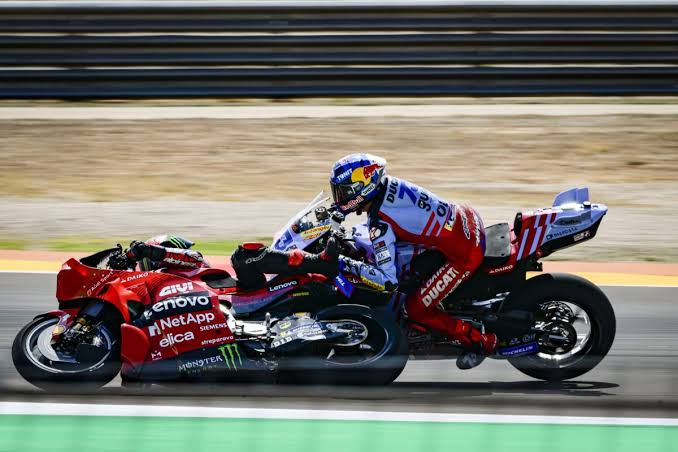Ducati’s Davide Tardozzi Defends MotoGP Ride Height Devices Amid Aragon GP Safety Concerns
Ducati’s team manager, Davide Tardozzi, has staunchly defended MotoGP’s ride height devices following a series of start issues at the Aragon Grand Prix that reignited debates over their safety.
The controversy arose after several riders, including Ducati’s Francesco Bagnaia, experienced significant wheelspin while launching from the grid during both the sprint race and the grand prix.
Bagnaia, starting third on the grid, struggled with traction off the line, leading to a near-miss with Gresini’s Alex Marquez during the sprint race.
Although the pair avoided contact initially, they later collided in the grand prix, adding to the tension surrounding
Criticism of the resurfaced Aragon track’s condition was swift, with riders expressing frustration over the lack of proper cleaning, particularly after Saturday’s rain brought dirt back onto the circuit. While the track was swept on Saturday evening, the rain rendered the efforts futile, as debris once again littered the start positions by the time of the grand prix.
Some commentators, particularly from TNT Sport, speculated that Bagnaia’s wheelspin issues were directly linked to the ride height devices. However, Tardozzi strongly refuted these claims, emphasizing the device’s role in reducing rear wheelspin rather than exacerbating it.
“I think that the device helps,” Tardozzi stated. He explained that the issues in the sprint were primarily due to environmental factors, not the technology itself. “It was a matter of sand on the ground, and race direction did everything possible for cleaning the race track, the start positions. But unluckily, it rained sand, and it was too sandy. Where the riders don’t pass in practice, it was completely dirty.”
Tardozzi passionately defended the advancements in MotoGP technology, rejecting calls to revert to older, less sophisticated bikes. “MotoGP is the maximum of technology.
You have to go ahead. If you want to go back 20 years, like somebody is asking to have the bikes of 20 years ago or 10 years ago, it’s not our view. We are looking forward to having more things, more technology, more future.”
He also dismissed comparisons between Bagnaia’s difficulties and a similar incident involving Marc Marquez in Austria, where Marquez struggled to re-engage his front start device, nearly colliding with Franco Morbidelli as a result.
Tardozzi attributed Marquez’s problem to a unique situation involving his front tire, arguing that the issue was driver error rather than a failure of the ride height device.
“Marc had a problem because of what happened to the front tire,” Tardozzi explained. “He was thinking that he had to put the front device in the last moment because he wanted to carry the corner as fast as possible to try to make the front tire hotter and hotter. That’s why he made a mistake. In Austria, Marc made a mistake.”
As the debate over ride height devices continues, Tardozzi’s defense highlights the ongoing tension between innovation and safety in MotoGP. While some argue for caution and a return to simpler technology, Ducati and others remain committed to pushing the boundaries of what is possible in the sport.
Leave a Reply